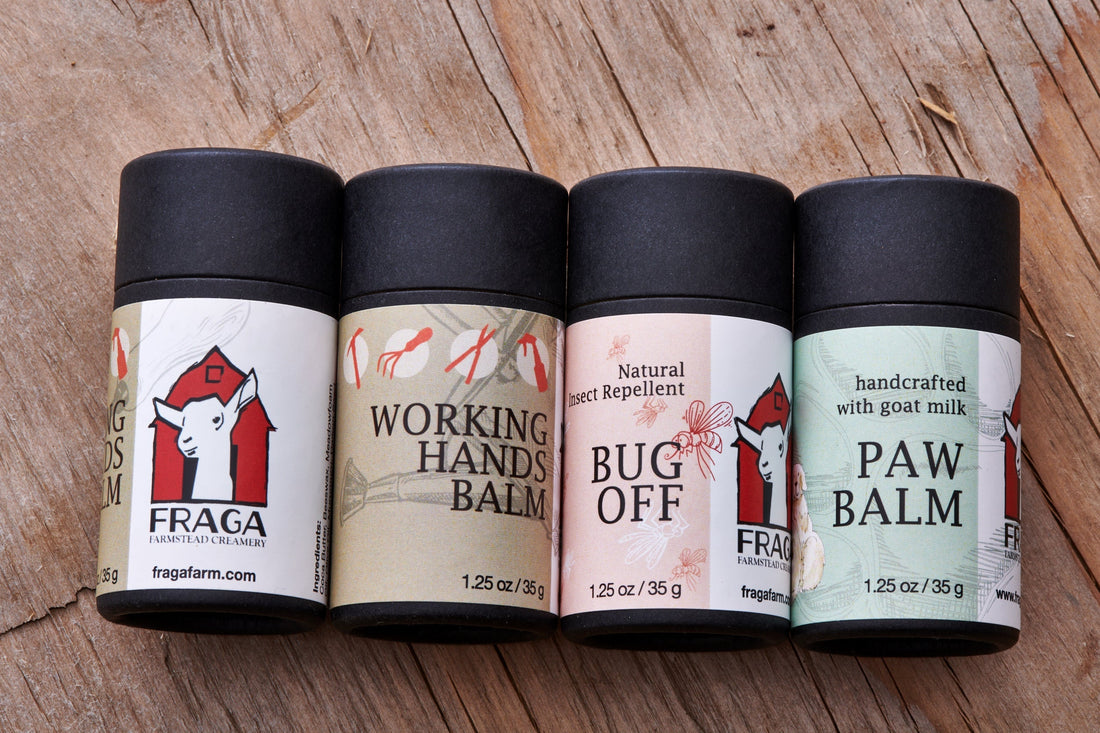What’s the Difference Between Balms and Lotions?
At its most basic: water. That’s the key difference.
Take a look at the ingredient list on a bottle of lotion, and you’ll find water—or aqua if you're reading INCI (International Nomenclature of Cosmetic Ingredients)—right at the top. (Fun fact: in INCI, goat’s milk is Capra Lac and beeswax is Cera Alba.)
Lotion also contains something balms don’t: humectants. Humectants are ingredients that draw moisture into the skin. Natural ones include honey, while synthetic versions include glycerin and hyaluronic acid.
But with water comes baggage: preservatives, emulsifiers, and thickeners. These are needed to keep the lotion from separating, curdling, or spoiling—because water creates a breeding ground for bacteria. Balms, on the other hand, don’t contain water. No water means no bacteria. The goat milk we use in our balm? It’s pasteurized, then freeze-dried to remove all water—right here on our farm.
Now let’s talk hydration. You might think lotions hydrate better because of all that water and humectants, but here’s the thing: most of that moisture only affects the outermost layer of skin—the stratum corneum—which is made up of dry, dead skin cells packed with keratin and surrounded by lipids. Humectants can temporarily plump up this layer, but unless you seal that moisture in with an occlusive (like a balm), it evaporates in minutes.
So why does a balm feel more hydrating—and why does the effect last?
Because it is. A balm’s strength lies in its ability to lock in moisture already present in your skin and prevent TEWL—that’s transepidermal water loss. We lose water through our skin just like we do when we fog up a mirror with our breath. A good balm can reduce that water loss by up to 60%.
Let’s break it down: we lose about 1 gram of water per hour just from our hands. That can jump to 10 grams with frequent washing. One gram is about 20 drops. Picture holding 20 drops of water in your cupped hands. That’s what a well-formulated balm can help you keep from losing.
Bonus tip: Apply balm right after washing—when your hands are still a little damp—to help seal in that moisture.
Now, why do most people still use lotion? It’s water, preservatives, stabilizers, emulsifiers… and more water. Usually about 80% of it. So why not just use a balm? The answer probably has more to do with marketing than skincare.
In the early 1960s, brands like Tide changed how consumers thought about products. During WWII, the plastics industry advanced rapidly to meet military needs—especially around waterproofing. After the war, those technologies were redirected toward consumer goods. Suddenly, companies could dilute powdered detergents with water, pour them into bulky plastic jugs, and charge more. Per load, the price went up—but people didn’t notice, because it looked like they were getting more.
Same goes for lotion. It’s a big bottle, but most of it’s water.
We often tell people at the market: One balm stick = one 12 oz bottle of lotion—the same amount of active ingredients, just concentrated into a compact, travel-ready form. And instead of being packaged in plastic, our balm sticks are made with certified forest-friendly cardboard tubes right here in Oregon.
They’re space-saving, mess-proof, and can even survive a forgotten afternoon in a hot car—just let them cool back down and they’re good as new.
And now that we know the average American ingests a credit card’s worth of plastic every week, we’re starting to rethink things. So the next time you’re asked “paper or plastic?” —go for paper.
Like our balm tubes.

